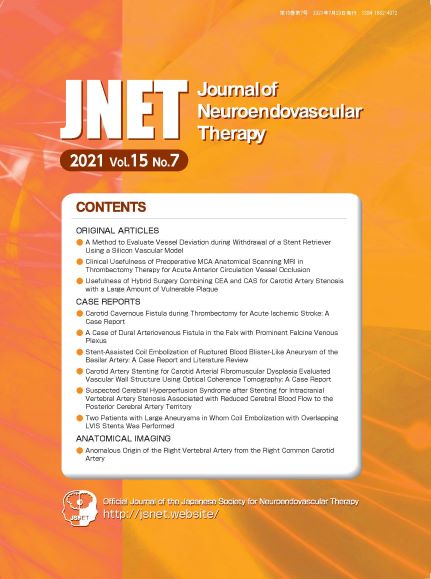15 巻, 7 号
選択された号の論文の11件中1~11を表示しています
- |<
- <
- 1
- >
- >|
ORIGINAL ARTICLES
-
2021 年15 巻7 号 p. 417-420
発行日: 2021年
公開日: 2021/07/20
[早期公開] 公開日: 2020/12/29PDF形式でダウンロード (673K) -
2021 年15 巻7 号 p. 421-428
発行日: 2021年
公開日: 2021/07/20
[早期公開] 公開日: 2021/01/06PDF形式でダウンロード (2139K) -
2021 年15 巻7 号 p. 429-437
発行日: 2021年
公開日: 2021/07/20
[早期公開] 公開日: 2021/01/20PDF形式でダウンロード (1800K)
CASE REPORTS
-
2021 年15 巻7 号 p. 438-443
発行日: 2021年
公開日: 2021/07/20
[早期公開] 公開日: 2020/12/29PDF形式でダウンロード (1377K) -
2021 年15 巻7 号 p. 444-448
発行日: 2021年
公開日: 2021/07/20
[早期公開] 公開日: 2020/12/29PDF形式でダウンロード (3047K) -
2021 年15 巻7 号 p. 449-455
発行日: 2021年
公開日: 2021/07/20
[早期公開] 公開日: 2021/01/20PDF形式でダウンロード (1006K) -
2021 年15 巻7 号 p. 456-459
発行日: 2021年
公開日: 2021/07/20
[早期公開] 公開日: 2020/12/29PDF形式でダウンロード (2883K) -
2021 年15 巻7 号 p. 460-466
発行日: 2021年
公開日: 2021/07/20
[早期公開] 公開日: 2021/01/06PDF形式でダウンロード (2251K) -
2021 年15 巻7 号 p. 467-474
発行日: 2021年
公開日: 2021/07/20
[早期公開] 公開日: 2020/12/29PDF形式でダウンロード (4120K)
ANATOMICAL IMAGING
-
2021 年15 巻7 号 p. 475-477
発行日: 2021年
公開日: 2021/07/20
[早期公開] 公開日: 2021/01/06PDF形式でダウンロード (1260K)
ERRATUM
-
2021 年15 巻7 号 p. 478
発行日: 2021年
公開日: 2021/06/25
PDF形式でダウンロード (113K)
- |<
- <
- 1
- >
- >|
